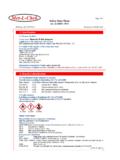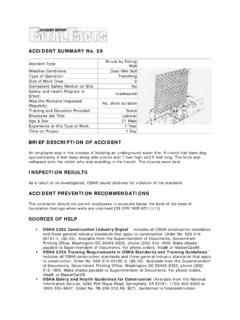Transcription of Hazard Communication Standard: Safety Data Sheets
1 BRIEFThe Hazard Communication Standard (HCS) (29 CFR (g)), revised in 2012, requires that the chemical manufacturer, distributor, or importer provide Safety data Sheets (SDSs) (formerly MSDSs or Material Safety data Sheets ) for each hazardous chemical to downstream users to communicate information on these hazards. The information contained in the SDS is largely the same as the MSDS, except now the SDSs are required to be presented in a consistent user-friendly, 16-section format. This brief provides guidance to help workers who handle hazardous chemicals to become familiar with the format and understand the contents of the SDSs. The SDS includes information such as the properties of each chemical; the physical, health, and environmental health hazards; protective measures; and Safety precautions for handling, storing, and transporting the chemical.
2 The information contained in the SDS must be in English (although it may be in other languages as well). In addition, OSHA requires that SDS preparers provide specific minimum information as detailed in Appendix D of 29 CFR The SDS preparers may also include additional information in various section(s). Hazard Communication Standard: Safety data Sheets Sections 1 through 8 contain general information about the chemical, identification, hazards, composition, safe handling practices, and emergency control measures ( , fire fighting). This information should be helpful to those that need to get the information quickly. Sections 9 through 11 and 16 contain other technical and scientific information, such as physical and chemical properties, stability and reactivity information, toxicological information, exposure control information, and other information including the date of preparation or last revision.
3 The SDS must also state that no applicable information was found when the preparer does not find relevant information for any required element. The SDS must also contain Sections 12 through 15, to be consistent with the UN Globally Harmonized System of Classification and Labeling of Chemicals (GHS), but OSHA will not enforce the content of these sections because they concern matters handled by other description of all 16 sections of the SDS, along with their contents, is presented below:Section 1: IdentificationThis section identifies the chemical on the SDS as well as the recommended uses. It also provides the essential contact information of the supplier. The required information consists of: Product identifier used on the label and any other common names or synonyms by which the substance is known.
4 Name, address, phone number of the manufacturer, importer, or other responsible party, and emergency phone number. Recommended use of the chemical ( , a brief description of what it actually does, such as flame retardant) and any restrictions on use (including recommendations given by the supplier).1 Section 2: Hazard (s) IdentificationThis section identifies the hazards of the chemical presented on the SDS and the appropriate warning information associated with those hazards. The required information consists of: The Hazard classification of the chemical ( , flammable liquid, category1). Signal word. Hazard statement(s). Pictograms (the pictograms or Hazard symbols may be presented as graphical reproductions of the symbols in black and white or be a description of the name of the symbol ( , skull and crossbones, flame).)
5 Precautionary statement(s). Description of any hazards not otherwise classified. For a mixture that contains an ingredient(s) with unknown toxicity, a statement describing how much (percentage) of the mixture consists of ingredient(s) with unknown acute toxicity. Please note that this is a total percentage of the mixture and not tied to the individual ingredient(s).Section 3: Composition/Information on IngredientsThis section identifies the ingredient(s) contained in the product indicated on the SDS, including impurities and stabilizing additives. This section includes information on substances, mixtures, and all chemicals where a trade secret is claimed. The required information consists of:Substances Chemical name.
6 Common name and synonyms. Chemical Abstracts Service (CAS) number and other unique identifiers. Impurities and stabilizing additives, which are themselves classified and which contribute to the classification of the Same information required for substances. The chemical name and concentration ( , exact percentage) of all ingredients which are classified as health hazards and are: Present above their cut-off/concentration limits or Present a health risk below the cut-off/concentration limits. The concentration (exact percentages) of each ingredient must be specified except concentration ranges may be used in the following situations: A trade secret claim is made, There is batch-to-batch variation, or The SDS is used for a group of substantially similar where a trade secret is claimed A statement that the specific chemical identity and/or exact percentage (concentration) of composition has been withheld as a trade secret is required.
7 1 Chemical, as defined in the HCS, is any substance, or mixture of substances. 2 Section 4: First-Aid MeasuresThis section describes the initial care that should be given by untrained responders to an individual who has been exposed to the chemical. The required information consists of: Necessary first-aid instructions by relevant routes of exposure (inhalation, skin and eye contact, and ingestion). Description of the most important symptoms or effects, and any symptoms that are acute or delayed. Recommendations for immediate medical care and special treatment needed, when necessary. Section 5: Fire-Fighting MeasuresThis section provides recommendations for fighting a fire caused by the chemical.
8 The required information consists of: Recommendations of suitable extinguishing equipment, and information about extinguishing equipment that is not appropriate for a particular situation. Advice on specific hazards that develop from the chemical during the fire, such as any hazardous combustion products created when the chemical burns. Recommendations on special protective equipment or precautions for firefighters. Section 6: Accidental Release MeasuresThis section provides recommendations on the appropriate response to spills, leaks, or releases, including containment and cleanup practices to prevent or minimize exposure to people, properties, or the environment. It may also include recommendations distinguishing between responses for large and small spills where the spill volume has a significant impact on the Hazard .
9 The required information may consist of recommendations for: Use of personal precautions (such as removal of ignition sources or providing sufficient ventilation) and protective equipment to prevent the contamination of skin, eyes, and clothing. Emergency procedures, including instructions for evacuations, consulting experts when needed, and appropriate protective clothing. Methods and materials used for containment ( , covering the drains and capping procedures). Cleanup procedures ( , appropriate techniques for neutralization, decontamination, cleaning or vacuuming; adsorbent materials; and/or equipment required for containment/clean up). Section 7: Handling and StorageThis section provides guidance on the safe handling practices and conditions for safe storage of chemicals.
10 The required information consists of: Precautions for safe handling, including recommendations for handling incompatible chemicals, minimizing the release of the chemical into the environment, and providing advice on general hygiene practices ( , eating, drinking, and smoking in work areas is prohibited). Recommendations on the conditions for safe storage, including any incompatibilities. Provide advice on specific storage requirements ( , ventilation requirements). 3 Section 8: Exposure Controls/Personal ProtectionThis section indicates the exposure limits, engineering controls, and personal protective measures that can be used to minimize worker exposure. The required information consists of: OSHA Permissible Exposure Limits (PELs), American Conference of Governmental Industrial Hygienists (ACGIH) Threshold Limit Values (TLVs), and any other exposure limit used or recommended by the chemical manufacturer, importer, or employer preparing the Safety data sheet, where available.
















